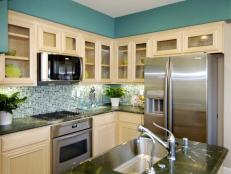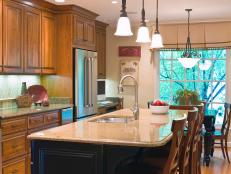Kitchen Remodeling: Where to Splurge & Where to Save An Informative Article from Your Friends at Albuquerque Cabinet Brokers!
The gourmet cook can justify an inflated budget for appliances and the splurge on a professional range. The entertainer sees a warming drawer and wine cooler as necessities. The busy family needs storage, storage … and more storage in those cabinets. And then there’s the question of resale: How important is it for you to get a nice return-on-investment for your project? Or, are you designing a kitchen for the home you plan to live in forever?
“Think about how you use the kitchen, and put your money there,” says Ellen Rady, Ellen Rady Designs, Cleveland, Ohio.
If you’re planning a kitchen you’ll live in for the next decade and you can’t afford certain materials you want today, consider placeholders. For example, rather than installing a granite countertop today, choose a laminate look-alike for at least half the cost that can stand in as your work surface until your budget allows for the upgrade.
Where to Save, Where to Splurge
Here is some general advice on where to save and splurge:
Appliances. Be practical and look for energy-efficient appliances with warranties—arguably, you’ll use appliances more than other features in your kitchen. But be sure to maintain a balance between what you spend on appliances and cabinets. If you choose appliances first without considering cabinets/hardware, countertops or other features, you can box yourself into a floor plan and end up without enough money to spend on other features.
But be careful which appliances you spend on. For example, a refrigerator may need replaced in 15 years or sooner, but a cooktop will last longer. Spend there. If you have children and dirty dishes are a way of life, invest in a quality dishwasher or dishwasher drawers that make your life easier.
Across the board, stainless steel is the most popular choice and what buyers look for in a home.
Countertops. If the countertop will be the focal point of your kitchen, you might spend more. “A stone countertop costs many times more than a laminate one, but will add beauty and value to your renovation,” Bauer-Kravette says.
In fact, a showpiece countertop could dictate the design in a kitchen—you may base decisions about cabinetry, color scheme and furniture like stools on the surface you choose. But remember, beauty is subjective. A buyer might not be that impressed.
There are shortcuts if you want the beautiful surface on a budget. For instance, there are assorted grades of granite (rated 1-5 or on various scales depending on the manufacturer). Rather than going for a grade 5, consider a grade 2, where you’ll get a better return-on-investment.
Also, some laminate products cost half the price of granite and mimic the design. You can’t put a hot pan on that surface, but you’ll get the appeal you want. You can even install an undermount sink with laminate countertops today.
If you want to splurge a little, choose a statement surface for the island—a remnant piece of granite with a beautiful pattern, for example.
Cabinetry. Some costs that can hike up cabinet prices: delivery, tax and installation. Drawers, roll-out trays, extra shelves and extending cabinets to the ceiling also add to the price tag. So will fitting out that corner cabinet. A Lazy Susan can add $1,500 to your budget.
A few musts: Definitely invest in a waste-recycling center, and be sure to choose cabinets with soft close drawers and doors, which has evolved from luxury to a “must” for convenience and resale. “The place to splurge is on functionality,” says John O’Meara of Hafele. Drawers in base cabinets are more ergonomic and provide better storage access; paying more to build wall cabinets up to the ceiling will give you much more storage.
Save on the actual cabinet material, Steinkoler suggests. “To the naked eye, you can have a veneer cabinet next to one that is solid wood and most people cannot tell the difference,” he says. Today’s finishes can offer rich looks without the big price tag.
On the other hand, Burgin says that cabinet sides and shelving should be constructed from plywood, not particle board. “Plywood is a good move for resale and keeping the cabinets strong,” he says.
Still, a quality pressed wood can last you 20 years. Just hone in on the cabinet construction, Rady advises. “Look for good, clean classic lines and full door overlay,” she says, noting that many of today’s mid-range priced cabinets offer a rich look without the custom price tag.
Don’t save on installation: let the pros take care of that. “To install a kitchen is much more than hanging boxes,” Rady says.
And don’t spend your budget on fancy drawer inserts that you can buy at a home store, Bauer-Kravette says. However, do spend on one good pantry with pull-out drawers and deep base cabinet drawers. “Extra drawers are so much better than door cabinets,” she says. “You won’t have to bend as much and they’ll be comfortable to use for years if you plan on staying in your home.”
Hardware. Knobs, pulls and handles can refresh the look of an entire kitchen—talk about a budget remodel. You can practically spend as much as you want on cabinet “jewelry,” from $1.25 a pull at a home store to $100 or more from a custom designer.
Overall, changing hardware provides a fast, affordable cabinet refresh. If you want to save money, choose the same type of pull you already have—switch knobs with knobs, and pulls with pulls. “Anytime you make a hole in wood, it does not grow back,” Bauer-Kravette says.
As for finish, you can update the look of your kitchen on the cheap by trading brushed stainless steel hardware for more on-trend oil-rubbed bronze, pewter and other time-worn, aged-looking metals. Don’t worry if your faucet is chrome and your drawer pulls are bronze. “You don’t have to match all of your metals,” Rady says. “Some variety makes the kitchen more interesting.”
Tile. While ceramic tile is great for backsplashes, go with porcelain on floors. Porcelain tile resists chipping and cracking, and is a favorite for budget and longevity. “It can be a terrific low-cost alternative to natural stone,” Bauer-Kravette says.
Keep in mind the size and pattern of tiles when figuring the budget. Consider large tiles for flooring, which give the kitchen an updated look and require fewer grout lines and cuts during installation.
Save money by purchasing a porcelain tile that looks like natural stone. Splurge on deco pieces such as glass-tile mosaics for a backsplash. Just space them out in the design—otherwise you’ll push up the price of installation (think of it like a puzzle … more pieces, more work).
Choose timeless styles. For instance, a sleek, white subway tile will grow old with a kitchen and never expire. Same goes for natural stones and neutral-colored tile.
Before you dig into your project, know your priorities so you can focus on spending where it’s most important. Here are some other pointers provided by the National Kitchen & Bath Association to help homeowners save on kitchen projects:
- Avoid structural changes, such as plumbing, mechanical systems and walls.
- Once you order products and installation begins, do not change your mind.
- Be specific when comparison shopping and be sure to compare exact products because prices can vary depending on model and even the finish.
- Visit showrooms in person and see the products—don’t rely only on the Internet to make purchase decisions.


















